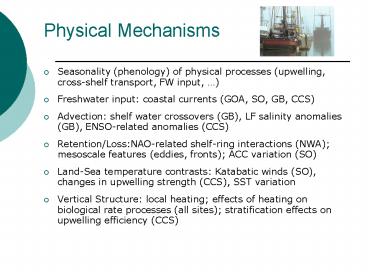Physical Mechanisms - PowerPoint PPT Presentation
Title:
Physical Mechanisms
Description:
Seasonality (phenology) of physical processes (upwelling, cross-shelf transport, FW input, ...) Freshwater input: coastal currents (GOA, SO, GB, CCS) ... – PowerPoint PPT presentation
Number of Views:46
Avg rating:3.0/5.0
Title: Physical Mechanisms
1
Physical Mechanisms
- Seasonality (phenology) of physical processes
(upwelling, cross-shelf transport, FW input, ) - Freshwater input coastal currents (GOA, SO, GB,
CCS) - Advection shelf water crossovers (GB), LF
salinity anomalies (GB), ENSO-related anomalies
(CCS) - Retention/LossNAO-related shelf-ring
interactions (NWA) mesoscale features (eddies,
fronts) ACC variation (SO) - Land-Sea temperature contrasts Katabatic winds
(SO), changes in upwelling strength (CCS), SST
variation - Vertical Structure local heating effects of
heating on biological rate processes (all sites)
stratification effects on upwelling efficiency
(CCS)
2
Biological Mechanisms
- Direct effects of heating on biological rate
processes (all sites) - Range shifts in spp due to temperature (or other)
variations - Changes in predator/prey relationships, ecosystem
structure (incl. range shifts) - Ecosystem efficiency (conversion of PP to HTL)
due to changes in food web components (e.g., food
chain length) - Are certain target spp mpre resilient/adaptable
to variability? - Relative time scales of advective processes to
life cycle closure times - Fronts/thin layers are exploitable by
intelligent organisms - Biogeochemical variability (e.g., ocean
acidification) --gt IMBER - Interaction b/w climate change human activity
(overfishing) on ecosystem resiliency (e.g.,
response to regime shift)
3
Temporal/Spatial Scales
- Tidal mixing shelf-slope fronts are hotspots of
NPP and HTL (NWA) - Topographically-controlled hot spots (Hecata Bank
in CCS has long residence times upwelling
shadows around capes/headlands) - Topographically-steered UCDW onto shelf (SO)
- Hypoxic events (CCS)
- Long-lived mesoscale eddies (e.g., Haida in GOA)
can transport coastal material offshore - Top Predators utilize hot spots (persistent
features or regions) for various ecological
functions (foraging, migration, reproduction) - Riverine inputs (nuts, FW, statification)
- Intraseasonal oscillations (NEP) SSWC-related
salinity anomalies (GB) storm events (all) - More (?) relevant ENSO, NAO, SAM (interannual to
decadal variability)
4
Attributes/Methods
- Low observability and predictability for episodic
events - Sample appropriately for the process being
studied (e.g., intraseasonal resolution to
capture spring transition) - Long-term HF moored samplers, satellite-based
sensors, species-specific sensors (taxonomic
info), ship-based studies, AUVs, gliders,
drifters/floats, electronic tags COUPLED to an
interactive, data-assimilative high-res
physical-biological model! - Need to maintain current capabilities in
satellite sensors (at least)































